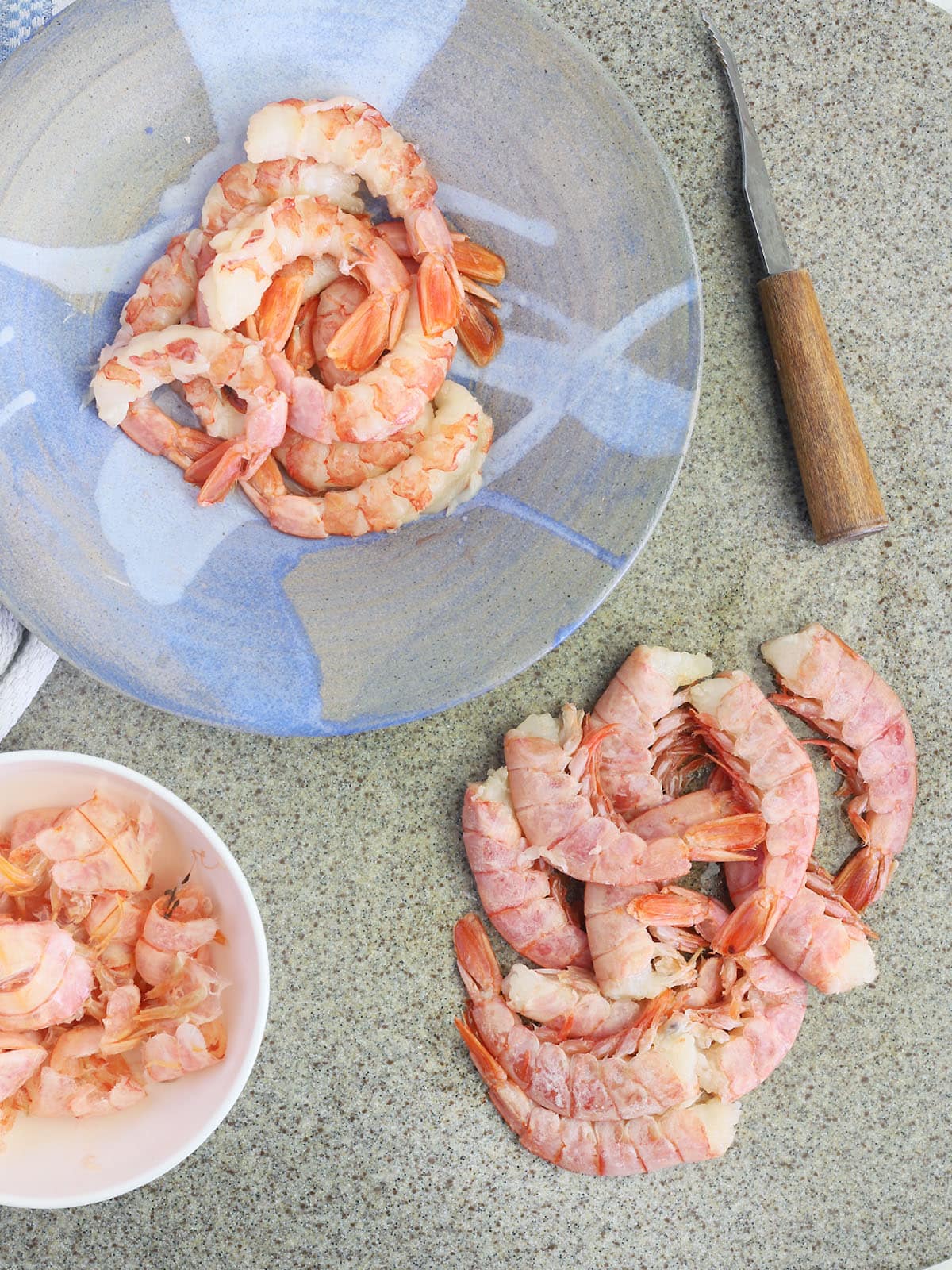How to Peel and Devein Shrimp
Love fresh shrimp? Save money by learning how to peel and devein shrimp yourself in four easy steps!

This post may contain affiliate links. Click here to learn more about how affiliate links are used on this site.
Once a year, my family and I make a trip to the beaches of the Alabama Gulf Coast. On our last full day, I get up early and head to our favorite seafood market to buy as many pounds of shrimp our budget will allow. We prefer royal red shrimp and we just can’t find royal red shrimp anywhere but on the coast.
Most seafood markets sell their shrimp by the pound three different ways: with the head still on, the shell on, or peeled and deveined. Purchasing shrimp with the head still on is the cheapest way to go. But it adds to your poundage, so you are essentially paying for less shrimp. However, there is a huge price gap between shell on and peeled and deveined. I’m not paying $2-3 dollars more per pound for something I can take care of myself in about 10 minutes.
How to defrost shrimp
Unless you are meeting the shrimp boats at the docks as they come in from their haul, you are buying frozen shrimp. Even the “fresh” shrimp sold behind the seafood counter at the grocery store has more than likely been previously frozen, then thawed. For the freshest shrimp, go with frozen.
Shrimp can go bad very easily; therefore, you need to thaw them carefully. If you don’t need the shrimp for a day or two, place the shrimp in a bowl in the refrigerator and let them thaw gradually over the course of 12-24 hours. You can even place the entire bag in the fridge, but I still recommend placing a bowl beneath the bag to catch any drips should the bag have an unseen hole. Be sure to cook the shrimp within that two-day window.
If you need the shrimp sooner than that, you can dump them in a bowl of cold water. After about 10 minutes, drain the water and refill the bowl. After about 20 minutes total, your shrimp should be thawed.
How to Peel Shrimp
I have seen various techniques on Pinterest and Tiktok on the best way to peel shrimp. Some people use the tines of a fork to peel and devein the shrimp in one fell swoop. I have tried this method, but most of my shrimp ended up mutilated. I’ll stick with my tried-and-true personal preference – my hands.
If you do happen to have shrimp with the head still on, simply hold the body of the shrimp between your thumb and index finger of one hand. With the other hand, use the same fingers to gently squeeze the head of the shrimp and pull straight back. It should come off easily.
Now for the shells. Again, hold the body of the shrimp in your dominant hand. Take the thumb of your other hand, slide it under the shell close to where the head used to be, and start peeling it back. Remove all the shells and the legs until you get to the tail.

Remove the tail or leave it on?
As you can see from the photos, I left the tails on (and consequently, I don’t have a picture of this step. But if you watch my video below, you will see how to do it). If I’m photographing shrimp, I leave the tails on. It makes a prettier presentation. However, they are not edible. Eventually you or the person you’re feeding will have to remove the tails before eating the shrimp and that can be a pain (especially if you’re hungry). When I’m preparing shrimp just to feed my family, I take them off.
Remove the tails in a similar fashion as you removed the head. Hold the shrimp in place with one hand. Using the thumb and forefinger of the other hand, gently squeeze the tail and pull straight back. After you’ve removed all the shells, you may be inclined to simply throw them in the trash – DON’T. The shells (including the heads) can be used to make excellent shrimp stock for use in gumbo, shrimp bisque, or this shrimp and corn bisque or other seafood-based recipes.
How to Devein Shrimp
First of all, what is the vein? If you look at the shrimp closely, you’ll notice there are actually two –a lighter vein that runs along the underside of the shrimp and a darker one that runs along the back. The one on the underside is a blood vessel. You don’t have to remove this one unless you absolutely want to (most people don’t).
The darker one along the back is the digestive tract. Essentially, it’s the shrimp’s poop. Before you get too grossed out, shrimp don’t have fecal matter like mammals do. It’s mostly full of sand and it won’t make you sick to eat it. But it can be unappetizing and if the shrimp is large, it can be gritty. No one likes gritty food.
The strange looking knife you see in my photos is a shrimp deveiner. I inherited it from a family member, so that’s why I have and use it. But it’s not essential for this task. Any sharp paring knife will work. Hold the shrimp sand vein side up in your non-dominant hand. Starting from the top of the shrimp, gently run the blade of your knife along the back to the tail, but don’t go all the way through. Spread the two split sides apart to reveal the vein. If you’re lucky, the shrimp will have already disgorged its digestive tract and it will be clean. But if you do run across one that’s got some sediment in it, take the tip of your knife to lift the vein up, then use your fingers to pull it out. Throw the veins away.




Now that you know how to peel and devein shrimp, try a few of these delicious shrimp recipes!


Thank you so much for your kind words, Buck!
6th generation Florida boy. Extremely familiar with cleaning shrimp. But your post was great. Simple, precise and short to the point. Excellent job. I also have that same deveining tool that I’ve sharpened to razor edge. Thanks and hope to read more of your stuff.